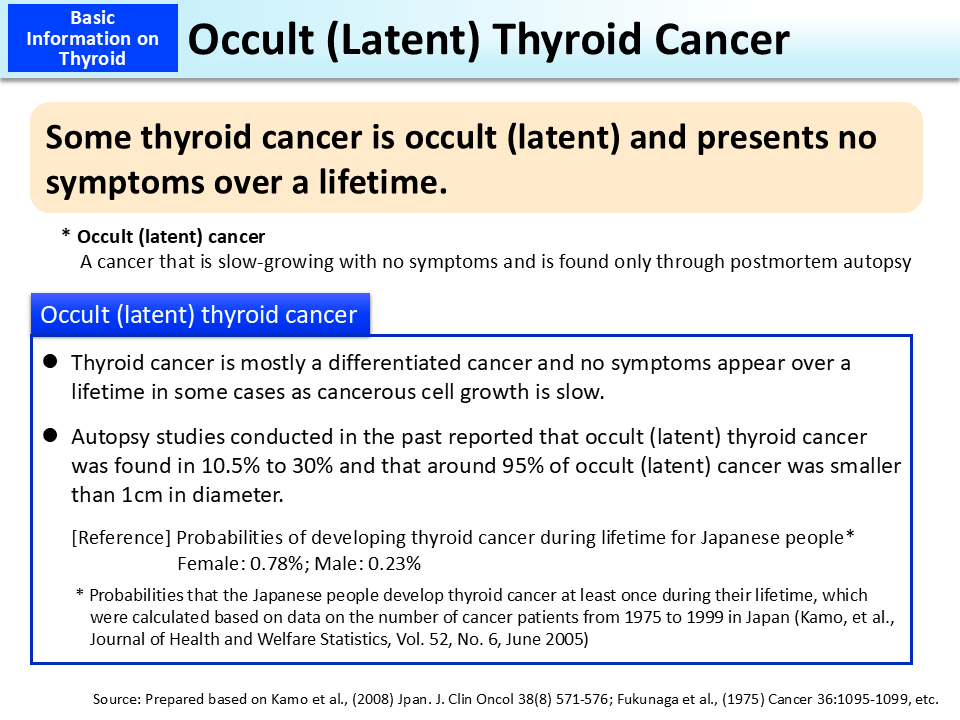Occult (Latent) Thyroid Cancer
Some types of cancer present no symptoms and exert no effects on people's health throughout their lifetime and are not clinically detected but are later found through histopathology diagnosis (including postmortem autopsy). Such cancer is called occult (latent) cancer.
One of the criteria for expressing the property of cancer cells is the degree of differentiation. This shows to what extent the relevant tumor resembles the normal tissue from which it originated, and the lower the degree is, the more malignant the tumor is and the easier the cancer grows.
Thyroid cancer is roughly categorized into differentiated cancer such as papillary cancer and follicular cancer, most of which are cancers with an especially high degree of differentiation, poorly differentiated cancer, undifferentiated cancer, and others. Out of these, in differentiated cancer, which accounts for the majority of thyroid cancer, cancer cells are mature and grow slowly and no symptoms appear over a lifetime in some cases. Such differentiated thyroid cancer is sometimes found as an occult (latent) cancer only through an autopsy conducted after a person's death due to other causes.
Based on an analysis using the cancer registry, probabilities that a Japanese person will develop thyroid cancer during his/her lifetime are 0.78% for females and 0.23% for males.1 The results of the five autopsy studies targeting Japanese and Japanese Hawaiians2-6 show that occult (latent) cancer was found with high frequency at 10.5% to 27.1% among males and 12.4% to 30.2% among females. In around 95% of the 525 cases found in the autopsy studies in Hiroshima and Nagasaki2 and the 139 cases found in the autopsy studies in Sendai and Honolulu,3 the sizes of tumors were smaller than 1cm.
These results also show that in many cases, thyroid cancer presents as an occult (latent) cancer without displaying symptoms throughout an individual’s lifetime.
- Kamo K et al., “Lifetime and Age-Conditional Probabilities of Developing or Dying of Cancer in Japan” Jpn. J. Clin. Oncol. 38(8) 571-576, 2008.
- Sampson et al., “Thyroid carcinoma in Hiroshima and Nagasaki. I. Prevalence of thyroid carcinoma at autopsy” JAMA 209:65-70, 1969.
- Fukunaga FH, Yatani R., “Geographic pathology of occult thyroid carcinomas” Cancer 36:1095-1099, 1975.
- Seta K, Takahashi S., “Thyroid carcinoma” Int Surg 61:541-4, 1976.
- Yatani R, et al., “PREVALENCE OF CARCINOMA IN THYROID GLANDS REMOVED IN 1102 CONSECUTIVE AUTOPSY CASES” Mie Medical Journal XXX:273-7, 1981.
- Yamamoto Y, et al., “Occult papillary carcinoma of the thyroid ~ A study of 408 autopsy cases~” Cancer 65:1173-9, 1990.
Source
- International Classification of Diseases for Oncology, Third Edition. First Revision, ICD-O, edited by the Director-General for Policy Planning and Evaluation (in charge of statistics and information policy) of the Ministry of Health, Labour and Welfare (printed by Toukei Insatsu Industries, 2018)
- General Rules for the Description of Thyroid Cancer (the 8the Edition) edited by the Japan Association of Endocrine Surgery and the Japanese Society of Thyroid Pathology (printed by Kanehara & Co., Ltd., Tokyo, 2019)
- Included in this reference material on March 31, 2020
- Updated on March 31, 2023

